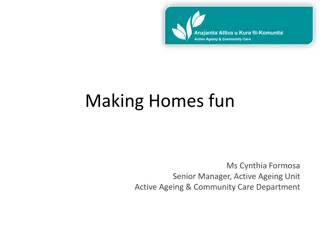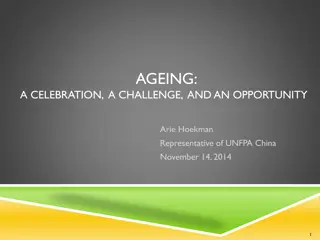Active Ageing and Social Partnership Project Overview
This project, funded by the European Commission, focuses on how social partners engage in promoting active ageing in the workforce. It aims to develop and implement interventions supporting older workers, investigate the shift towards active ageing, and provide resources for social partners. An agreement on active ageing has been reached between various organizations, emphasizing health, intergenerational working, and social dialogue. Key questions revolve around creating multi-generational workplaces, managing extended working lives for older workers, current support measures, and the role of social dialogue. The context highlights demographic changes, rising life expectancy, the incentive to work longer, and the diverse roles older workers often play.
- Active Ageing
- Social Partnership
- European Commission
- Workforce Engagement
- Intergenerational Workplaces
Uploaded on Dec 09, 2024 | 0 Views
Download Presentation

Please find below an Image/Link to download the presentation.
The content on the website is provided AS IS for your information and personal use only. It may not be sold, licensed, or shared on other websites without obtaining consent from the author. Download presentation by click this link. If you encounter any issues during the download, it is possible that the publisher has removed the file from their server.
E N D
Presentation Transcript
Active Ageing and Social Partnership Matt Flynn
Our team CROW (UK) Fondazione Adapt Matt Flynn Chris Ball Paolo Tomassetti In partnership with: Trades Union Congress Employers Forum for Equality & Inclusion In partnership with: CISL Funzione Pubblica FederDistribuzione University of Granada University of Lodz Mariano Sanchez Pilar Diaz Iza Warwas Justyna Wiktorowicz Piotr Szukalski In partnership with: UGT Andaluc a Conferencia de Empresario de Andaluc a In partnership with: NSZZ Solidarnosc Business Centre Club
About the project European Commission funded How social partners (unions and employers) engage on workforce active ageing Aims and objectives: develop, pilot and embed human resource management (HRM) interventions which support older workers reconcile competing intergenerational interests investigate ways in which social partners are shifting from an early retirement toward active ageing orientation Provide resources (online and training) to support social partners in promoting active ageing
Agreement on Active Ageing Agreement reached between Business Europe, UEAPME, CEEP, ETUC, Eurocadres, CEC Increased awareness and understanding of employers, workers, and their representatives of the challenges and opportunities derived from demographic change Tools and measures to be taken into account of impact of demographic change Emphases on: Health and activity up to legal retirement age Intergenerational working Social dialogue
The questions were asking: What does your organisation think about a multi-generational and diverse work places? What do you think older workers want in terms managing extended working life? What is being done now to support older workers and promote active ageing? How can social dialogue help?
Context Aging population rising life expectancy and falling fertility big gap in 40s Government is incentivising working longer Many people would like to work longer and are capable Many older workers have caring responsibilities for older relatives, children, grandchildren Rising proportion in self employment (but often not by choice) A range of specialised roles exist, but are rare (mentoring, quality assurance, training, consulting) A significant group of highly qualified older people choose to downshift to less stressful roles Employers need to plan to manage and motivate
Collusion toward early retirement State/employer incentives for early retirement Employers Shedding higher paid/higher status workers Making way for younger workers Government Achieving full employment Reducing industrial unrest Unions Protecting the right to retire Preventing contingent workforce tamping down wages Job creation for younger workers
Industrial relations: Four models Union membership: 26% Agency model Strong class roots Emphasis on individual rather than collective rights Union membership: 35% Multi-employer bargaining model Particularism- devolved collective bargaining Weak vertical/stronger horizontal integration Union membership 19% National collective bargaining since 2008 History of social concertation Flexibilisation resulting from reforms in 2012 Union membership: 12% Catholic ideological axis Non-union works councils Union/non-union, employer and government representation via Council of Social Dialogue
Pensions and welfare: Four models Pension replacement rate: 29% Pension age rising to 68 by 2039 Liberal residual/Beveridgian welfare state Basic state pension Workplace pension Some longer working life incentives Pension replacement rate: 93.2% Pension ages 66 men & public sector women/ 62 women Previdenza Obbligatoria: minimum basic pension Previdenza Complementare: DC for staff employed after 1995 Pension replacement rate: 81.8% Pension age rising to 67 by 2027 Mixed/Bismarckian system Anticipated Retirement: Early retirement Partial/flexible retirement: Late retirement Pension replacement rate: 38.6% Pension ages were rising to 67. Now 60/65 PAYG Guaranteed minimum pension Mandatory 2ndtier DC system/ Occupation Pension Plans
What has changed? Rising healthy life expectancy Changing retirement patterns and expectations European Union targets to increase older workers labour market participation Employment Equality (Age) Directive 2001/ Age regulations Intersectionality of age and other protected characteristics Abolition of mandatory retirement in some countries Pension changes Rising pension ages Increased risk for workers (DB to DC schemes) Elimination of early retirement routes (national and organisational) Creation of late retirement incentives
Social activation policies Single Equalities Act 2010 Abolition of Default Retirement Age 2010 Apprenticeship Levy 50+ (Humber); Older and Bolder (North East) Mid-life career review Worker Statute Act 2003 (Age+ intersectionality) Financial incentives for employers to hire 50+ Mobility allowance 36 months 50+ employees Mandatory retirement lawful but OW can delay claiming pension Age discrimination regs 2013 Abolition of mandatory retirement (except civil servants) Action Framework for Older People 2014 Integral Programme of Employment (Andaluc a) PEEP: Internships (Andaluc a) 2004 Amendment to EU Labour Code Mandatory retirement lawful European Year of Active Ageing 2011 Solidarity between Generations: 2008: Skills and Qualifications Emphasis on entrepreneurship and self-employment
Health and well-being Wide variety of health and ability amongst older workers One third of older inactive would like to work/one third of inactive work with a disability Stress highest in mid-career; job insecurity highest at periphery Job insecurity can be as bad on health as job loss Job control, autonomy, manageable workloads associated with good health
Health and well-being: Ideas NHS Working Longer Review Group (UK): review of longer working lives on all health sector professionals 55+ Strategy (Spain): Amelioration of working conditions for 55+ Volkswagen Poznan (Poland): emphasis on health checks, outpatient care, rehabilitation, job rotation Bilateral bodies (Italy): Jointly managed funds to finance activities to support at risk workers
Skills and training Skills shortages are widespread, and skills demands are rising, raising demand for some older workers Older workers less likely to have (current/ any) formal qualifications which are valued by employers Older workers are unlikely to consider themselves to have a training need Employers less likely to train older workers, but training more universal in expansive organisations
Skills and training: Ideas Midlife Career Review (UK): National pilot supported by unions, National Career Service, Learning Work Institute to provide career advice 50+ Unionlearn (UK): Learning reps to promote training/ skills audits Fondi paritetici interprofessionali per la formazione continua: Funds for retraining via bilateral bodies Action Framework for Older People (Spain): Organising training to keep older workers skills updated
Joblessness and recruitment High levels of youth unemployment and concern over lump of labour Long-term unemployment 50+ workers Distressed older worker fearing displacement Prevalence of age discrimination in job seeking Experience but no formal qualifications Employers can do more to develop the talent pipeline , especially for older people considering changing career direction Skills issues for small businesses
Joblessness and recruitment- ideas Barclays Bolder Apprenticeship (UK) Life course work centres (UK) ACTIVE 55+ (Andaluc a) (Spain) Pension top-ups for long term unemployed (Poland) Progetto Ponti (Intergenerational Solidarity Pacts) (Italy)
Flexible working The most frequently requested form of change Informal flexible work arrangements more common than formal arrangements(flexitime, part-year, job sharing) Organisational benefits (reputation, flexible firm) Restricts career progression More accepted if universal not just for special groups
Flexible working- ideas Phased Retirement BAE System (UK) Right to request flexible working (UK) Active Retirement: Pension incentives to return to work (Spain) Intergenerational Relays (Italy)
Performance management Formal and informal both matter Relationships, and trust are critical Line managers central to effective management Older workers are less likely to receive it Some younger managers find it difficult with older employees
Performance management - ideas British Telecom Wind Down/Step Down/Helping Hands/Ease Down (UK) Lifecourse Representatives (UK)
How can social dialogue help? Giving older workers voice on their work environments Balancing workforce demands and employees expectations Sharing good practice between and within organisations Investigating and innovating jointly Facilitating dialogue at the: Organisational level- Developing, piloting and embedding active ageing HRM Workplace level- Managing change in the workplace Individual level- Supporting older workers and their managers discuss plans
What are the barriers to dialogue? Ageist assumptions of capabilities/skills Limited career paths for older workers Lack of adaptability of HRM policies Collusion (perceived and unwitting) against active ageing
Intergenerational conflict or solidarity? Lump of labour theory or fallacy? Are there career paths for younger workers? Do younger workers feel that they have a say over their work? Are they involved equally in reinventing an active ageing workforce? Interdependence of older and younger people Transfer upward (e.g. pensions and eldercare) Transfer downward (e.g. financial support and grandparenting) Transfer of skills and knowledge Mentoring Intergenerational work teams
What interventions could promote active ageing? Demographic funds (IT) Mid-career reviews (UK) Intergenerational training and mentoring (ES) Redesigned work processes (PL)
Who should be involved in the dialogue? Unions National level Workplace/works council Local reps Employers Senior managers Local managers Occupational Health Government Economic partnerships (e.g. LEPs, HR networks)
How to maintain an Active Ageing workplace Leadership from the top of organisations/unions Knowing where to get resources and share good practice Building intergenerational solidarity Use structures to resolve problems early Joint management of demographic resources Joint reviews of workforce demographic changes Disseminating and sharing good practice with small businesses Developing bespoke regional approaches to age management
Questions for you: How does active ageing intersect with social partnership? Are there dimensions which resonate with you? Are there areas which merit further investigation? How should we enhance impactfulness? What training do social partners need? How can we make our online tool useful to social partners? How should we ensure sustainability? Are there more partners with whom to work? How do we encourage social partners take the baton?
Wed welcome your input! www.adapt.it/aspire @agediversity www.facebook.com/agediversity www.agediversity.org m.flynn@agediversity.org























